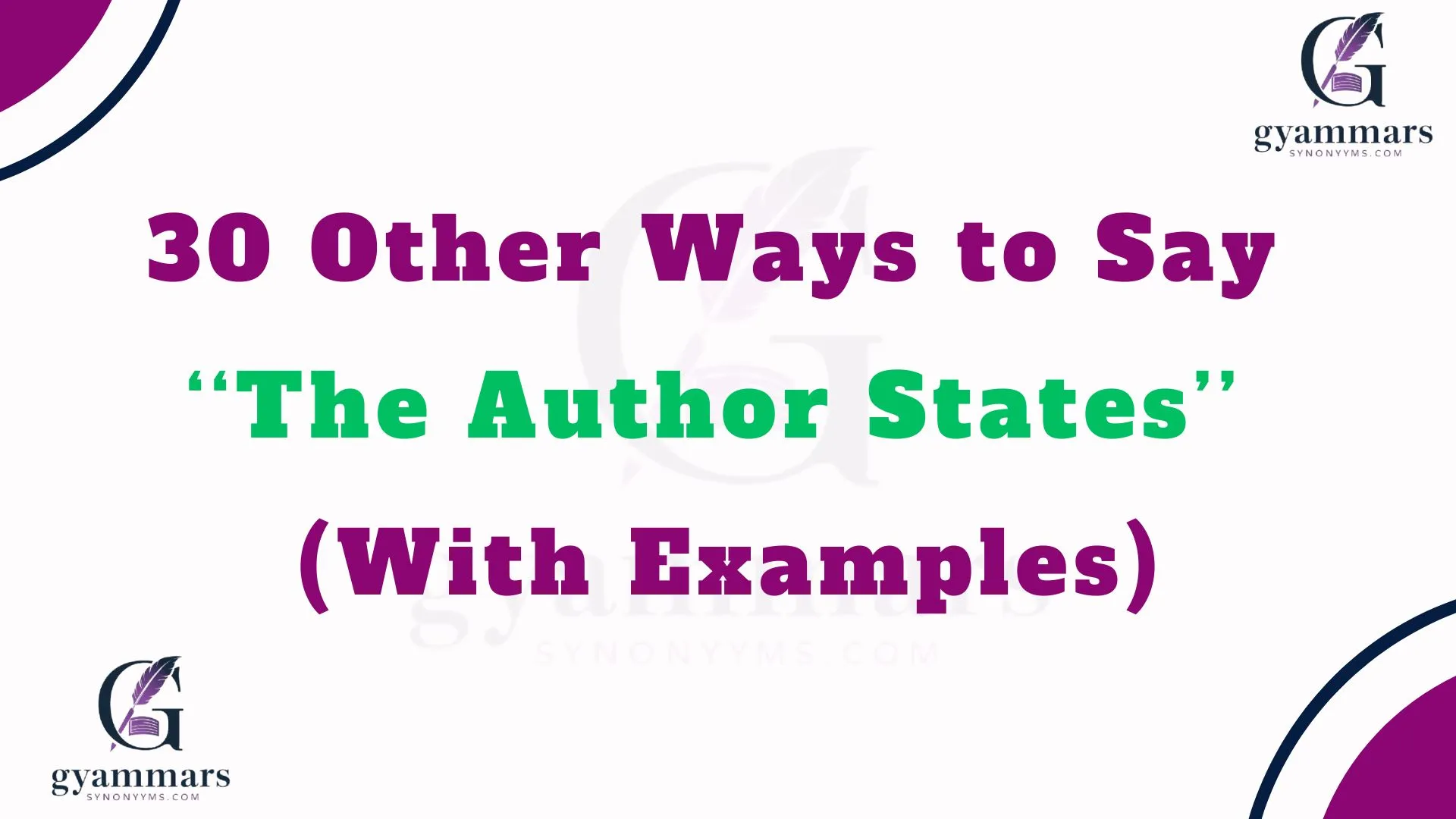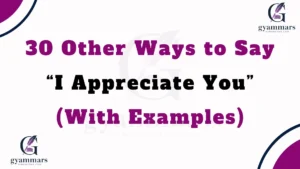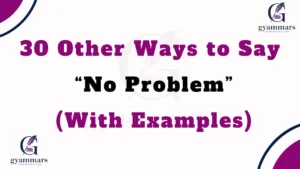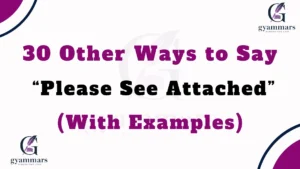Finding the right words can transform a simple message into something warm, engaging, and deeply meaningful. Whether you’re a student, researcher, or just someone who wants to express thoughts with more care and thoughtfulness, the way you introduce someone’s words matters. Saying “The author states” is common, but it can sometimes feel dry or impersonal. If you want your writing to feel more engaging and nuanced, here are 30 thoughtful alternatives – each with its own unique tone and best use.
What Does “The Author States” Mean?
“The author states” is a phrase used to introduce a point, argument, or statement made by an author in their work. It is often used in academic, journalistic, and analytical writing to attribute ideas.
Is It Professional/Polite to Say “The Author States”?
Yes! “The author states” is neutral, professional, and widely accepted in formal writing. However, it can sometimes feel stiff or repetitive. Using alternatives can help you create a more engaging and dynamic discussion.
Pros and Cons of Using “The Author States”
Pros:
- Clear and straightforward
- Professional and neutral
- Widely accepted in academic writing
Cons:
- Can feel repetitive
- May lack warmth or engagement
- Doesn’t always capture the tone or intent of the author’s words
Synonyms For “The Author States”
- The author asserts
- The author argues
- The author articulates
- The author conveys
- The author declares
- The author describes
- The author elaborates
- The author emphasizes
- The author expresses
- The author explains
- The author highlights
- The author illustrates
- The author implies
- The author indicates
- The author insists
- The author maintains
- The author mentions
- The author notes
- The author observes
- The author points out
- The author proposes
- The author puts forth
- The author reasons
- The author refers to
- The author remarks
- The author reiterates
- The author reports
- The author suggests
- The author underscores
- The author writes
1. The Author Asserts
Definition: To state something confidently or forcefully.
Explanation: Used when an author is firmly stating their opinion or position on a subject.
Scenario Example:
“In the study, the author asserts that climate change is the most pressing global issue.”
Best Use: Academic and persuasive writing.
Tone: Strong, confident, authoritative.
Additional Notes: Best used when an author is making a bold claim or strong argument.
2. The Author Argues
Definition: To present reasons in support of a viewpoint.
Detailed Explanation: Used when an author is making a persuasive case for their opinion or thesis.
Scenario Example:
“The author argues that technology has significantly impacted human relationships, citing multiple studies.”
Best Use: Essays, articles, debates.
Tone: Persuasive, analytical.
Additional Notes: Great for situations where the author is actively trying to convince the reader.
3. The Author Articulates
Definition: To express thoughts clearly and effectively.
Detailed Explanation: This suggests the author is carefully explaining their point.
Scenario Example:
“The author articulates the emotional challenges of overcoming grief through personal anecdotes.”
Best Use: Narrative and analytical writing.
Tone: Thoughtful, eloquent.
Additional Notes: Use when the author is explaining something with clarity and depth.
4. The Author Conveys
Definition: To communicate or express something.
Detailed Explanation: Used when an author effectively communicates an idea or emotion.
Scenario Example:
“The author conveys the importance of community through the protagonist’s relationships.”
Best Use: Literary analysis, personal essays.
Tone: Warm, expressive.
Additional Notes: Best when discussing how an author emotionally or conceptually communicates something.
5. The Author Declares
Definition: To state something clearly and officially.
Detailed Explanation: Used when an author makes a strong, formal, or official statement.
Scenario Example:
“The author declares that the policy changes are necessary for economic stability.”
Best Use: Official reports, persuasive writing.
Tone: Strong, definitive, authoritative.
Additional Notes: Best for situations where an author is making a firm proclamation.
6. The Author Describes
Definition: To give details about something in a vivid or explanatory way.
Detailed Explanation: Used when an author is painting a picture with words or providing in-depth details.
Scenario Example:
“The author describes the beauty of the countryside through rich imagery.”
Best Use: Literary analysis, storytelling, creative writing.
Tone: Visual, descriptive, engaging.
Additional Notes: Works well when analyzing literary or artistic expression.
7. The Author Elaborates
Definition: To expand on a point with additional details.
Detailed Explanation: Used when an author is providing deeper insight into a topic.
Scenario Example:
“The author elaborates on the effects of climate change by referencing multiple scientific studies.”
Best Use: Academic, analytical writing.
Tone: Informative, detailed.
Additional Notes: Ideal when discussing complex or multifaceted ideas.
8. The Author Emphasizes
Definition: To highlight something as especially important.
Detailed Explanation: Used when an author is stressing a point for effect.
Scenario Example:
“The author emphasizes the importance of mental health support in schools.”
Best Use: Essays, opinion pieces, persuasive writing.
Tone: Urgent, strong, persuasive.
Additional Notes: Best used when you want to show importance or urgency.
9. The Author Expresses
Definition: To share thoughts, emotions, or ideas.
Detailed Explanation: Used when an author is communicating personal feelings or subjective viewpoints.
Scenario Example:
“The author expresses deep sorrow over the loss of natural habitats due to deforestation.”
Best Use: Personal essays, creative writing, literary analysis.
Tone: Emotional, heartfelt, reflective.
Additional Notes: Best when the author’s personal emotions or perspectives are involved.
10. The Author Explains
Definition: To make something clear and understandable.
Detailed Explanation: Used when an author is clarifying or breaking down complex ideas.
Scenario Example:
“The author explains how economic inflation impacts consumer behavior.”
Best Use: Academic writing, journalism, instructional content.
Tone: Clear, educational, neutral.
Additional Notes: Great for when an author is teaching or informing.
11. The Author Highlights
Definition: To draw attention to something significant.
Detailed Explanation: Used when an author is pointing out key details or ideas.
Scenario Example:
“The author highlights the dangers of misinformation in digital media.”
Best Use: Research, analysis, editorial writing.
Tone: Focused, important, attention-grabbing.
Additional Notes: Ideal when an author is bringing attention to something crucial.
12. The Author Illustrates
Definition: To explain something using examples, comparisons, or imagery.
Detailed Explanation: Used when an author is demonstrating an idea with clear examples or visuals.
Scenario Example:
“The author illustrates the impact of social media addiction through real-life case studies.”
Best Use: Literary analysis, academic writing, research papers.
Tone: Clear, explanatory, engaging.
Additional Notes: Works well when the author uses vivid descriptions or concrete examples.
13. The Author Implies
Definition: To suggest something without stating it directly.
Detailed Explanation: Used when an author is hinting at an idea instead of explicitly stating it.
Scenario Example:
“The author implies that wealth does not always lead to happiness through the protagonist’s struggles.”
Best Use: Literary analysis, persuasive writing.
Tone: Subtle, indirect, thought-provoking.
Additional Notes: Best used when analyzing underlying meanings or hidden messages in texts.
14. The Author Indicates
Definition: To point out something, often as evidence or support.
Detailed Explanation: Used when an author is referencing facts or directing the reader to a conclusion.
Scenario Example:
“The author indicates that diet plays a crucial role in overall health.”
Best Use: Scientific writing, research papers.
Tone: Informative, neutral.
Additional Notes: Ideal for when an author is citing facts or making evidence-based claims.
15. The Author Insists
Definition: To state something forcefully and repeatedly.
Detailed Explanation: Used when an author strongly believes in a point and refuses to waver.
Scenario Example:
“The author insists that traditional education methods are outdated and need reform.”
Best Use: Opinion pieces, debates, argumentative writing.
Tone: Strong, unwavering, assertive.
Additional Notes: Best when an author firmly stands by their point without compromise.
16. The Author Maintains
Definition: To continue to assert something as true.
Detailed Explanation: Used when an author is consistently defending a position or belief.
Scenario Example:
“The author maintains that climate change is primarily driven by human activity.”
Best Use: Academic, political, and research writing.
Tone: Confident, firm, evidence-based.
Additional Notes: Good when an author sticks to their argument despite opposition.
17. The Author Mentions
Definition: To bring up something briefly.
Detailed Explanation: Used when an author refers to an idea without going into detail.
Scenario Example:
“The author mentions the economic crisis but does not elaborate further.”
Best Use: Summarizing, casual writing.
Tone: Neutral, brief, passing.
Additional Notes: Works best when an author touches on a point without deep exploration.
18. The Author Notes
Definition: To observe or acknowledge something in a written work.
Detailed Explanation: Used when an author recognizes or points out a fact, observation, or detail.
Scenario Example:
“The author notes that recent advancements in AI have reshaped the job market.”
Best Use: Research papers, academic writing, journalism.
Tone: Neutral, objective, informative.
Additional Notes: Best for stating facts or summarizing key takeaways.
19. The Author Observes
Definition: To comment on something based on perception or study.
Detailed Explanation: Used when an author is making an insightful or analytical remark.
Scenario Example:
“The author observes that social media has changed how people form friendships.”
Best Use: Analytical writing, opinion pieces.
Tone: Reflective, insightful, thoughtful.
Additional Notes: Works well when discussing patterns, behaviors, or societal trends.
20. The Author Points Out
Definition: To bring attention to a specific fact or issue.
Detailed Explanation: Used when an author is making something clear to the reader.
Scenario Example:
“The author points out that obesity rates have been rising despite health campaigns.”
Best Use: Essays, discussions, journalism.
Tone: Direct, neutral, informative.
Additional Notes: Great for emphasizing key facts or drawing attention to important details.
21. The Author Proposes
Definition: To put forward an idea or suggestion for consideration.
Detailed Explanation: Used when an author introduces a new concept, plan, or theory.
Scenario Example:
“The author proposes a new approach to mental health treatment in schools.”
Best Use: Research, academic papers, policy discussions.
Tone: Constructive, forward-thinking.
Additional Notes: Best when discussing new ideas, solutions, or recommendations.
22. The Author Puts Forth
Definition: To present an idea or argument in a serious way.
Detailed Explanation: Similar to “proposes,” this phrase is used when an author formally introduces a thought, claim, or hypothesis.
Scenario Example:
“The author puts forth the argument that history education needs to be more inclusive.”
Best Use: Academic and formal writing.
Tone: Formal, professional, structured.
Additional Notes: Works best when presenting theories, arguments, or structured viewpoints.
23. The Author Reasons
Definition: To explain or justify an idea logically.
Detailed Explanation: Used when an author is building a logical case or drawing conclusions.
Scenario Example:
“The author reasons that excessive screen time can lead to sleep disturbances.”
Best Use: Persuasive writing, logical arguments, analysis.
Tone: Rational, structured, analytical.
Additional Notes: Ideal for arguments based on logical reasoning and evidence.
24. The Author Refers To
Definition: To mention something as a source or point of discussion.
Detailed Explanation: Used when an author references a study, person, event, or theory.
Scenario Example:
“The author refers to recent studies on climate change to support their argument.”
Best Use: Academic writing, research, analysis.
Tone: Neutral, objective.
Additional Notes: Best for citing sources or building arguments with references.
25. The Author Remarks
Definition: To comment on something in an informal or notable way.
Detailed Explanation: Used when an author makes a general or personal comment.
Scenario Example:
“The author remarks that human nature has remained largely unchanged despite technological advancements.”
Best Use: Essays, literary discussions, personal reflections.
Tone: Casual, reflective, conversational.
Additional Notes: Good for engaging, thoughtful discussions rather than strict academic writing.
26. The Author Reiterates
Definition: To repeat something for emphasis or clarity.
Detailed Explanation: Used when an author emphasizes a previously stated idea.
Scenario Example:
“The author reiterates that early childhood education is essential for lifelong success.”
Best Use: Persuasive writing, speeches, reports.
Tone: Strong, insistent, persuasive.
Additional Notes: Works well when stressing key arguments or important takeaways.
27. The Author Reports
Definition: To present information in a factual, neutral manner.
Detailed Explanation: Used when an author delivers facts or findings from a study, event, or research.
Scenario Example:
“The author reports that sales have increased by 20% over the past quarter.”
Best Use: Journalism, research reports, scientific articles.
Tone: Objective, factual, neutral.
Additional Notes: Best for stating findings without adding opinion or interpretation.
28. The Author Suggests
Definition: To propose an idea without forcing it as a conclusion.
Detailed Explanation: Used when an author presents an idea as a possibility rather than a fact.
Scenario Example:
“The author suggests that a balanced diet can improve mental health.”
Best Use: Research papers, self-help articles, recommendations.
Tone: Thoughtful, open-minded.
Additional Notes: Best when an author is offering ideas rather than making firm claims.
29. The Author Underscores
Definition: To emphasize something as very important.
Detailed Explanation: Used when an author wants to highlight a critical point.
Scenario Example:
“The author underscores the importance of early childhood education.”
Best Use: Essays, persuasive writing, research.
Tone: Strong, serious, persuasive.
Additional Notes: Ideal for stressing the significance of an idea or argument.
30. The Author Writes
Definition: A neutral way to introduce an author’s statement.
Detailed Explanation: Used when an author simply records or states something in a general way.
Scenario Example:
“The author writes about the effects of globalization on local economies.”
Best Use: General writing, journalism, academic work.
Tone: Neutral, flexible.
Additional Notes: Works in almost any context but may lack the nuance of other alternatives.
Conclusion
Choosing the right phrase instead of “The author states” can make your writing more engaging, precise, and expressive. Whether you want to sound persuasive, objective, or conversational, using these alternatives can help you communicate with more warmth, clarity, and thoughtfulness.
FAQs
1. Why should I avoid using “The author states” repeatedly?
Using the same phrase repeatedly can make your writing sound repetitive and monotonous. By incorporating a variety of alternatives, you can make your writing more engaging, precise, and expressive, ensuring your message resonates with the reader.
2. Which alternative is best for academic writing?
For academic writing, “The author argues,” “The author explains,” “The author maintains,” and “The author reports” are strong choices. They convey a formal, clear, and evidence-based tone, which is essential for scholarly work.
3. Which alternative is best for casual or creative writing?
For casual or creative writing, “The author expresses,” “The author describes,” and “The author illustrates” work well. These alternatives add warmth and personality, making the writing more engaging and relatable.
4. How do I choose the right synonym for my sentence?
Consider the tone and intent of your writing. If the author is presenting facts, use “reports” or “notes.” If they are persuading, use “argues” or “insists.” If they are offering ideas, try “suggests” or “proposes.” Matching the word to the context ensures clarity and effectiveness.
5. Can I mix multiple alternatives in one piece of writing?
Absolutely! Using a variety of alternatives makes your writing more dynamic and engaging. Just ensure that each alternative fits the context and tone to maintain clarity and coherence.
Also Read This:
30 Other Ways to Say ‘Think Outside the Box’ (With Examples)
Compare vs Contrast: A Deep Dive into Their Key Differences and Uses
Pre vs Post: Which Prefix to Use? A Practical Guide with Examples
30 Other Ways to Say ‘I Will Do My Best’ (With Examples)
30 Other Ways to Say ‘No Worries’ (With Examples)
30 Other Ways to Say ‘Will Do’ (With Examples)
Quit vs Resign: Clear Up the Confusion Once and For All
Tying or Tieing? The Right Way to Spell It

“Emma Rose at Grammar Synonyms is your go-to expert for everything related to language and expression. Whether you’re refining your grammar, searching for the perfect synonym, or looking for creative ways to improve your writing, Emma Rose provides the tools and inspiration you need. With a wide range of resources designed to elevate your communication, Grammar Synonyms helps you find just the right words to make every sentence shine.












